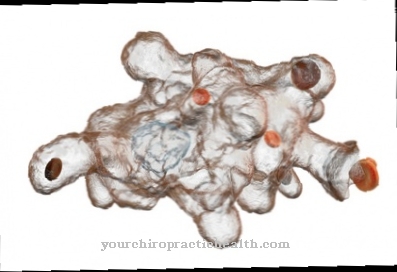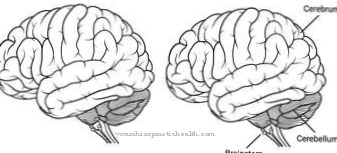Long QT Syndrome is the name of a heart disease that can be life-threatening. This leads to a pathologically prolonged QT interval.
What is Long QT Syndrome?

© tverdohlib - stock.adobe.com
At the Long QT Syndrome it is a life-threatening disease of the heart that rarely occurs. It can be hereditary as well as acquired in the course of life. People whose hearts are otherwise healthy can suffer sudden cardiac death from long QT syndrome.
There are different congenital long QT syndromes, including Jervell and Lange Nielsen syndrome (JLNS) and Romano Ward syndrome, which are usually inherited as an autosomal dominant trait. The name long QT syndrome goes back to an increase in the QT time during an EKG (electrocardiogram). The frequency-corrected QT time is more than 440 milliseconds.
A typical characteristic of heart disease is palpitations, which occurs like a seizure. Torsade de pointes tachycardias, which are considered life-threatening, are not uncommon. The cardiac arrhythmia threatens dizziness, sudden loss of consciousness and ventricular fibrillation with cardiac arrest. In many cases, however, the affected people do not suffer from any discomfort.
causes
Long QT syndrome is triggered by minor deviations in the electrical transmission of signals in the heart muscle cells. There is a delayed repolarization of the action potential, which concerns the plateau phase, which is also called phase 2. Due to abnormal properties of the ion channels, a prolongation of the plateau phase occurs in congenital (innate) long QT syndrome.
The ion transport of the potassium ion channel either decreases or there is an increased transport capacity of the sodium ion channel. The action potential forms an important basis for stimulating the heart muscle cells. It is regulated by the interaction of the ion currents. Phase 0 of the action potential is the depolarization of the heart muscle cells, which is caused by the influx of calcium and sodium ions.
The repolarization is initiated by phase 1, during which the outflow of potassium from the cell takes place. Phase 1 is followed by phase 2 or the plateau phase, during which the long-lasting influx of calcium ions takes place. These ions trigger the release of additional calcium ions from the sarcoplasmic reticulum.
It takes about 100 milliseconds for the calcium channels to close again, for the calcium to escape from the cell or return to the stores and the heart muscle begins to relax. This is followed by phase 3, in which the membrane potential returns to its starting position. There it remains in a state of rest until the next excitation occurs.
The congenital long QT syndrome is caused by an ion channel dysfunction that is mutation-related and results in a structural change in an ion channel. In addition to the congenital form, which arises from a gene mutation, there are also acquired forms of heart disease. They can be caused by inflammation of the heart muscle (myocarditis), circulatory disorders, electrolyte disorders, or the use of various medications.
The responsible drugs include, above all, class I, II and III antiarrhythmics, psychotropic drugs and various antibiotics that inhibit repolarization and trigger drug-induced long QT syndrome.
Symptoms, ailments & signs
If symptoms arise from the long QT syndrome, it is an abrupt onset of torsades de pointes tachycardias. The ventricular tachycardia is noticeable through sweating, general malaise, tightness in the chest and heart restlessness. In addition, a circulatory collapse (syncope) can set in.
A collapse and tachycardia occur mainly in stressful situations or during physical exertion. If the ventricular tachycardias are not treated medically, there is a risk of ventricular fibrillation, which leads to permanent cardiac arrest and ends in the death of the patient.
Diagnosis & course of disease
If a long QT syndrome is suspected, the attending physician will perform a resting ECG. Sometimes a stress ECG can also be useful. If the QT interval increases during the resting ECG, this is considered to be a groundbreaking indication of the syndrome. The frequency-corrected QT time (QTC) is 450 milliseconds for men, while it is 470 milliseconds for women.
Because long QT syndrome is usually inherited, family history is very important for diagnosis. In addition, a molecular genetic mutation detection within the leukocyte DNA is possible. For this purpose, a PCR amplification and the sequencing of the known risk genes are carried out. Two to five milliliters of EDTA blood are used for the sample material.
The course of long QT syndrome depends on whether or not you experience symptoms. The prognosis is negative if symptoms appear and no treatment is carried out. In principle, however, it is possible to help most patients with appropriate therapy.
Complications
Long QT syndrome is a very dangerous disease which, in the worst case, can lead to patient death. For this reason, long QT syndrome definitely requires treatment from a doctor. As a rule, those affected suffer from strong sweats and also from malaise. This significantly limits and reduces the quality of life.
In the further course, the person affected can also suffer a circulatory collapse and lose consciousness in the process. A loss of consciousness often leads to injuries that can occur in the event of a fall. Especially in stressful situations, there are significant impairments due to the long QT syndrome. The resilience of the person concerned is significantly reduced and it comes to a tiredness and fatigue.
Heavy stress can also lead to cardiac arrest and thus to death in the patient. As a rule, the symptoms of long QT syndrome can be limited and treated with the help of medication. In general, there are no particular complications. In acute emergencies, however, the use of a defibrillator is necessary to revive the person concerned. Life expectancy is limited and reduced by the long QT syndrome.
When should you go to the doctor?
If seizures or signs of cardiac arrhythmia occur, it is best to call an emergency doctor. Symptoms of this kind indicate a serious condition and in the worst case can lead to the death of the patient. If the person concerned loses consciousness, the emergency doctor must be called. At the same time, the relatives should provide first aid and make sure that the person affected can get air and have a pulse. Less serious symptoms that require clarification are shortness of breath, rapid exhaustion and audible palpitations.
Chest pain should also be clarified quickly by a doctor. People at risk include people who take medication regularly or who have low serum potassium levels. A slow heart rhythm can also cause long QT syndrome. Anyone who belongs to the risk groups should pay close attention to any warning signs and, if in doubt, make an appointment with a doctor. The appropriate doctor is the cardiologist. The individual symptom profile is treated by the family doctor and various specialists and specialists (such as neurologists or physiotherapists).
Treatment & Therapy
The standard treatment for congenital long QT syndrome is the administration of beta-blockers. These are able to significantly reduce severe cardiac arrhythmias. If syncope still persists, the use of an implantable defibrillator (ICD) is advisable. The implantation should also take place after a cardiac arrest.
If the long QT syndrome is caused by taking certain medications, the triggering agent must be discontinued immediately. In contrast to the congenital form, the administration of beta blockers does not make sense because they pose the risk of bradycardia, which in turn increases the risk of life-threatening cardiac arrhythmias. In contrast, the supply of magnesium is considered a tried and tested means.
Physical stress is classified as problematic in a long QT syndrome. This applies particularly to sudden onset or end of stress, as well as pressure fluctuations and cold.
Outlook & forecast
If left untreated, long QT syndrome leads in most cases to circulatory collapse, loss of consciousness and premature death. Since this is a life-threatening health development, there is an acute need for action. Intensive medical care is necessary so that no permanent damage occurs and the survival of the person concerned is ensured. Consultation with a doctor should be sought as soon as the first irregular heartbeat occurs.
If the diagnosis is made early, the further course of the disease is significantly improved and the probability of survival is increased. The affected person needs the implantation of a defibrillator. This ensures sufficient heart activity in the long term and can regulate cardiac activity restrictions. Although the surgical procedure is associated with risks, it is still a routine procedure. If no further complications arise, the patient will be able to continue living.
The mental as well as physical stresses must, however, be adapted to the possibilities of the organism and must be reduced. In many cases the restructuring of everyday life is necessary so that no disruptions occur and risk factors are minimized. The person concerned must have regular long-term check-ups with a doctor so that irregularities can be recognized and corrected at an early stage. This can lead to emotional states of stress. In addition, medication must be administered after the defibrillator is used. These are fraught with side effects.
prevention
In order to prevent cardiac arrhythmias caused by long QT syndrome, sports such as diving, swimming, surfing, tennis, weight lifting and bodybuilding should be avoided. In contrast, moderate physical activities such as skating, walking or jogging are considered useful.
Aftercare
Since long QT syndrome cannot heal itself, follow-up care focuses primarily on alleviating the existing symptoms. Those affected suffer from severe pain in the heart and continue to be permanently tired and exhausted. As a result, in most cases they are dependent on help from their social environment. Since the stress on everyone involved is sometimes very high, this can lead to depression and other psychological upsets.
It is therefore advisable to seek professional psychological help to make it easier to deal with the disease. A gentle mode in everyday life with many phases of rest can help to compensate for the permanent inner restlessness and any sleep problems that may arise. Since the further course of the disease depends heavily on the time of diagnosis, no general prediction can be made. In addition, the exchange with other sufferers of the long QT syndrome can counteract your own helplessness and promote a more self-confident handling of the situation.
You can do that yourself
As a rule, the possibilities for self-help with long QT syndrome are severely limited. This is especially the case if the syndrome is not triggered by certain medications but is due to a heart disease.
However, if the long QT syndrome is triggered by taking medication, it must be stopped immediately or replaced with other medication. Changing and stopping medication should always be done after consulting a doctor. Furthermore, the symptoms of long QT syndrome can be reduced by taking beta blockers. The patient should ensure that they are taken regularly. The increased intake of magnesium can also have a positive effect on the course of the disease and alleviate the symptoms. Magnesium can be ingested either through the intake of supplements or through various foods, such as nuts or fish.
Because of the long QT syndrome, the person affected should continue to avoid heavy physical exertion. This also includes doing without strenuous sports. Above all, stress should not set in suddenly, as this unnecessarily stresses the heart. Likewise, the person concerned should not stay too long in the cold and avoid pressure fluctuations that can occur, for example, when flying or diving.


.jpg)
.jpg)









.jpg)

.jpg)
.jpg)











.jpg)